Cinnamon Raisin Sourdough Bread
This post may contain affiliate links. Please read our disclosure policy.Cinnamon and raisin are a perfect flavor combination. Enjoy this sweet cinnamon sourdough bread studded with raisins and baked in an artisan style loaf. It’s the perfect bread for your morning toast. I love slathering it with a little bit of butter and enjoying the sweet cinnamon raisin flavor. And guess what, the kids love it too!

Why You’ll Love Cinnamon Raisin Sourdough Bread
This easy-to-follow recipe uses a cinnamon sugar paste instead of sprinkling sugar straight onto the dough. I made too many loaves with dough that was overly wet and difficult to shape until I realized I could make a paste like I use in my sourdough cinnamon rolls. This gives me a little extra time to shape the dough and results in a perfect cinnamon sugar flavor. In short, this cinnamon raisin sourdough bread is just delicious. You’ll be wanting it on repeat!

Important Ingredients in Cinnamon Raisin Sourdough Bread
- Sourdough Starter: Use an active/ripe sourdough starter (doubled in size/bubbly/mild sour aroma) to mix the levain.
- Bread Flour: I almost always use a 12.5% protein bread flour for my breads. This cinnamon raisin sourdough is mixed with a high water content and needs to be paired with a strong flour. If you don’t have bread flour and substitute all-purpose, you will need to reduce some of the water in the recipe.
- Water: I use tap water in my baking and usually warm it up to help keep the dough warm during the fermentation process. If the dough is cold, the fermentation will move more slowly.
- Salt: Salt enhances the flavor and helps temper the fermentation – don’t leave it out!
- Raisins: Use any good quality raisins that you like in this recipe. I do not soak the raisins before adding them into the dough. I purposefully increase the hydration of the dough to compensate for the raisins soaking up some of the moisture. If you choose to use soaked raisins, decrease the water in the recipe by 25 grams.
- Cinnamon Sugar Mixture: Cinnamon sugar can often be difficult to add into a high hydration sourdough bread. It makes the dough sticky quickly because sugar absorbs water. To help compensate for that, this recipe calls for a paste of cinnamon/sugar mixed with softened butter, a little flour and a pinch of salt. Mix the paste together and spread it over the dough after bulk fermentation and right before shaping.
Sample Baking Schedule for Cinnamon Raisin Sourdough
A sample baking schedule helps me when baking with sourdough. Sourdough takes much longer to rise than commercial yeast bread. This schedule helps me plan my bake.
A few notes: This schedule assumes the dough temperature is 78°F throughout the process. If you’d like to make the bread all on the same day, skip the cold fermentation and let the dough rise for a few hours in a banneton before baking.
| Day 1 | Levain/Mixing/Bulk Fermentation/Shaping/Cold Fermentation |
| 8:00 AM – 11:30 AM | Mix Levain. Let sit at 78°F for about 3-4 hours until doubled/bubbly and ripe. |
| 11:30 AM | Begin Bulk Fermentation Fermentolyse: Mix bread flour, whole wheat flour, water and ripe/active/bubbly levain. Let sit for 30 minutes before adding in the salt and reserved water. |
| 12:00 PM | Mix dough with salt and reserved water |
| 12:30 PM 1:00 PM 1:30 PM | Stretch and Fold #1 Stretch and Fold #2 Add raisins Stretch and Fold #3 |
| 1:30 PM – 4:00 PM | Bulk Fermentation Continued |
| 4:00 PM | Add Cinnamon/Sugar Mixture Shape and begin cold fermentation |
| Day 2 | |
| 9:00 AM | Preheat Dutch oven |
| 9:30 AM | Score and Bake |
How to Make Cinnamon Raisin Sourdough Bread
Mix Levain
1:1:1 Levain (ready in 3-4 hours/same day): This recipe calls for a levain mixed the same day you mix the dough. It should take 3-4 hours until it’s ready to be mixed with the dough, if you keep the levain temperature at 78-80°F. Levain is ready when it has doubled in size, has lots of bubbles, a slightly sour aroma and is just about to start going down from its peak height. Mix together:
- 35 grams of ripe/mature starter
- 35 grams of warm water
- 35 grams of bread flour
If you prefer to mix the levain the night before, you can mix a 1:10:10 levain that is ready in 10-12 hours or overnight. Mix together:
- 5 grams of ripe/mature sourdough starter
- 55 grams water
- 55 grams bread flour
Do you have to use a levain in this recipe? No. I prefer it, but if you have a well-maintained and frequently refreshed starter, you can substitute that in place of the levain in the recipe.
Begin Bulk Fermentation: Fermentolyse
As soon as the levain is ready (bubbly, doubled in size, peaked), mix together the ripe levain, bread flour, whole wheat flour and water. This method is called a fermentolyse, and it helps strengthen the gluten strands in the dough before the salt is added. Salt has a shrinking effect on the gluten strands, so doing this first gives a better overall texture and crumb to this bread. Cover the dough, set it in a warm (78°F) place and let it rest for 30 minutes.
After 30 minutes, add the salt and 25 grams of reserved water. Pinch chunks of dough and reincorporate them together gently. Pick up one side of the dough and fold it over on itself. Wet your hands as needed and continue to work with the dough, gently kneading until all the ingredients are incorporated and the dough is smooth. This will probably take 3-5 minutes. If you prefer doing this step in a stand mixer, that works too. Transfer the dough to a plastic container or a glass bowl if desired.

Bulk Fermentation: Stretch and Folds
Sourdough cinnamon raisin bread is an artisan style bread, which means we don’t use traditional kneading methods, instead we use a series of gentle folds to help strengthen the gluten strands in the dough. This dough usually gets about 3-4 sets of stretch and folds over a 2 hour period, if the dough is kept right around 78°F.
Stretch and Fold: To stretch and fold, wet your hand (so it doesn’t stick to the dough). Reach down to the bottom of the bowl of dough and pull the dough up and over the top of the dough. Turn the bowl a quarter turn and repeat the stretch and fold. Turn another quarter turn and repeat. Perform one more quarter turn with stretching and folding the dough. Cover and set aside for 30 minutes. Repeat every 30 minutes for a total of 3-4 times.
Adding Raisins: Right before your second set of stretch and folds, add the raisins on top of the dough. As you stretch and fold the dough, the raisins will incorporate. Alternatively, you can use coil folds to add the raisins if you prefer. As you repeat your stretch and folds or coil folds a third time and as the dough rests, the raisins will incorporate throughout the dough.

Bulk Fermentation: Resting
After the 2-hour period of stretch and folds, let the dough rest in a warm 78-80°F place until puffed up and jiggly with a few scattered bubbles around the top. Because we are not going to pre-shape this dough due to the addition of the cinnamon/sugar, this process usually takes about 2-3 hours. If the dough isn’t showing signs it is ready to shape, give it another half hour and check again.

Adding Cinnamon Filling to Cinnamon Raisin Sourdough Bread
Preparing Cinnamon Sugar Mixture: One of the tricky parts of adding cinnamon sugar into a high hydration sourdough loaf, is that the sugar works to pull moisture out of the dough. This happens quickly and the dough can become difficult to work with if you spend too long trying to shape the dough. To counteract this process, I mix together a filling of softened butter, brown sugar, ground cinnamon, a little flour and salt until it forms a thick paste.
Adding Filling to Sourdough: Once the dough has rested and is showing signs of readiness, prepare a banneton or small bowl. Place a kitchen towel or hair net in the bowl and liberally flour. Dump the dough out on the counter. Wet your hands and pull the dough out into a square or rectangle shape. The dough does not need to be stretched very thinly. Dollop most of the cinnamon sugar mixture on top of the dough, working quickly and spreading it across the dough. Fold one side of the dough to the middle and the other side of the dough to the middle. Add the rest of the cinnamon sugar mixture on top of that dough and then roll the dough up into a cylinder or circular shape. Immediately place the dough into a prepared banneton or bowl.



Cold Fermenting Cinnamon Raisin Sourdough Bread
Cover the dough with plastic wrap or a shower cap and place in the refrigerator for 18-24 hours. If it goes a little longer than that, it should be okay – up to as much as 48 hours depending on the temperature of your refrigerator and how quickly the fermentation is moving.
Want to bake the same day? Skip cold fermentation. Cover the dough and let rise in a warm 78-80°F place for about 2-3 hours until puffed up, jiggly and risen. Pre-heat Dutch oven and bake.


Baking Cinnamon Raisin Sourdough Bread
Pre-heat the Oven: Put a Dutch oven (top and all) into the oven and preheat to 500°F. Allow the Dutch oven to heat for about 30 minutes to an hour at 500°F. This builds up steam, which is necessary to achieve the beautiful oven spring and crispy crust that artisan bread is known for.
Scoring the Dough: Once the oven is preheated for 30 minutes, pull the loaf out of the refrigerator. Remove the plastic wrap (this is easy to do straight out of the refrigerator if the dough is chilled – not easy if the dough warms up) and place a piece of parchment paper on top of the bread dough. I like using parchment in this recipe because sometimes the cinnamon sugar will leak out, which I don’t like getting on my Dutch oven. Flip the dough over so that it is now sitting on the parchment paper. Take off the bowl/banneton and kitchen towel. Use a bread lame or very sharp knife to score the dough. I find a simple score, nothing too intricate, is best when working with this dough. If a raisin pops out, just take it out completely or else it will burn.
Baking the Bread: Carefully remove the Dutch oven from the 500°F oven with hot pads. Take the top off and place your bread into the Dutch oven (including parchment paper – this helps with the transfer). Be very careful not to touch the sides of the hot Dutch oven. Put your hot pads back on before you pick up the lid of the Dutch oven and place it on top of the bread. Put the whole Dutch oven back into your oven. Lower the temperature to 450°F and bake for 20 minutes. Once 20 minutes are up, take the top off the Dutch oven and continue baking for 20 minutes until the bread is fully baked. Let cool completely before slicing and enjoy!



Recipe Tip
Cinnamon has antimicrobial properties which means it can slow down fermentation. Always add cinnamon at the end of bulk fermentation and watch your dough closely. It may need a little longer to ferment once the cinnamon sugar is added.
Substitutions
If you don’t want raisins in your cinnamon raisin sourdough, you can leave them out completely and replace them with another dried fruit. This recipe is specifically formatted to allow the raisins to soak up some of the moisture in the dough. If you choose not to use raisins or any dried fruit, decrease the water in the dough by 25 grams.

How to Store Leftovers
After the cinnamon raisin sourdough loaf has cooled completely, slice it up into pieces. Place sliced bread in a plastic bag, push air out and freeze. This bread toasts up well straight from the freezer into the toaster or defrosts to enjoy a slice later.
If you liked this you’ll also like
Looking for more recipes like this cinnamon raisin sourdough bread? Check out: Caramelized Onion Sourdough / Gingerbread Sourdough / Honey Whole Wheat Sourdough Artisan Bread / Sourdough Artisan Bread / Pumpkin Sourdough / Chocolate Sourdough Artisan Bread / Jalapeno Cheddar Sourdough / Cranberry Pecan Sourdough
Frequently Asked Questions
You can leave the raisins out or replace them with another dried fruit. This recipe is specifically formatted to allow the raisins to soak up some of the moisture in the dough. If you choose not to use raisins, you may want to decrease the water in the dough by 25 grams.
I don’t add cinnamon straight into my dough because cinnamon has antimicrobial properties that can slow down the fermentation in a loaf. This is why you often see cinnamon swirled into bread and not added directly to it.
I prefer the flavor, color and time management aspect that cold fermentation allows, but if it works better for you to bake the loaf sooner, you can cover the loaf and let it rise in a warm place (78-80ºF) for 2-3 hours until puffed up, jiggly and risen another 20-30%. Then pre-heat the dutch oven and bake.

Cinnamon Raisin Sourdough Bread
Ingredients
Levain (1:1:1, 3-4 hours until doubled if kept at 78ºF)
- 35 grams sourdough starter ripe, bubbly, active
- 35 grams water
- 35 grams all-purpose or bread flour
Cinnamon Raisin Sourdough Bread
- 100 grams levain ripe, bubbly, active
- 400 grams water 25 grams reserved for AFTER the fermentolyse
- 450 grams bread flour 12.5% protein content, see recipe notes
- 50 grams whole wheat flour
- 10 grams salt reserved for AFTER the fermentolyse
- 120 grams raisins about 1 cup, reserved for after stretch and folds
Cinnamon Filling (reserved for after bulk fermentation)
- 58 grams unsalted butter, softened about 4 Tablespoons
- 60 grams brown sugar about 1/4 cup
- 6 grams ground cinnamon about 2 teaspoons
- 3 grams all-purpose or bread flour about 1 teaspoon
- pinch of salt
Instructions
Day 1: Levain/Mix/Bulk Fermentation/Shape/Cold Bulk Fermentation (keep dough at 78ºF for best results)
- Levain: Mix together 35 grams ripe sourdough starter, 35 grams all-purpose or bread flour and 35 grams water. Set aside to ripen for 3-4 hours, keeping the temperature at 78ºF. Levain is ready when it has doubled in size, is very bubbly, smells milky sweet and is just about to fall.
- Fermentolyse: Once the levain is peaked and active, mix 100 grams levain with 375 grams of water in a large bowl. Warm the water if the ingredients are too cold and cool the water if ingredients are too warm. Add the 450 grams bread flour and 50 grams whole wheat flour to the bowl and mix until incorporated and a shaggy dough forms. Let rest for 30 minutes.
- Mixing: After 30 minutes, add the reserved salt and reserved 25 grams of water. Combine using your hands by squeezing the dough between your fingers, pinching chunks of dough and reincorporating together. The dough will break apart and then reform in the bowl through this process. Pick up one side of the dough and fold it over on itself. The dough will be sticky. Wet your hands as needed and continue to work with the dough, slapping it against the side of the bowl and stretching it back until all the salt and water have been incorporated and the dough is cohesive and strong. Alternatively you can perform this step in a stand mixer. Transfer the dough to a plastic container or bowl if desired.
- Bulk Fermentation: Perform 3-4 sets of "stretch and folds," adding the raisins in during the second set.
- To “stretch and fold,” wet your hand (so it doesn’t stick to the dough). Reach down to the bottom of the bowl of dough and pull the dough up and over the top of the dough. Turn the bowl 1/4 turn and repeat the stretch and fold. Turn another quarter turn and repeat. Perform one more 1/4 turn with stretching and folding the dough. Cover and set aside for 30 minutes.
- Add raisins: Before performing the second set of stretch and folds, add the raisins on top of the dough. Stretch and fold the dough again, incorporating the raisins in as you go. Cover and set aside for 30 minutes. Repeat the third and fourth set of stretch and folds every 30 minutes for the next hour.
- Bulk Fermentation Continued: Let the dough rest in a warm place, for the rest of bulk fermentation, about 2-3 hours at 78ºF. During this time the dough will puff up about 30-40%, become more aerated, start to pull away from the edges of the bowl and have a few scattered bubbles around the edges/top of the dough. If your dough is not showing these signs, make sure it's warm enough and give it another half an hour or so until it is showing signs that it's ready to shape.
- Mix Cinnamon Filling: Mix together 58 grams softened butter, 60 grams brown sugar, 6 grams ground cinnamon, 3 grams flour and a pinch of salt until it forms a paste. Set aside.
- Shaping: When the dough is showing signs that it's ready to shape, dump the dough out onto the countertop. Gently pull the dough into a 12 by 12 square shape. It does NOT need to be very thinly stretched, see post pictures for example. Dollop most of the cinnamon mixture on the top of the dough. Fold one side of the dough to the middle and then the other side of the dough to the middle. Add the rest of the cinnamon sugar mixture on top of that dough. Then roll the dough up into a cylinder or circular shape. Immediately place the dough in the prepared banneton basket without too much handling of the dough. Cinnamon sugar tends to release moisture in the dough making it necessary to work quickly and get it in the banneton.
- Cold Bulk Fermentation: Cover the dough with plastic wrap or a shower cap and store in the refrigerator overnight for about 18-24 hours. Alternatively you can let your dough rise outside the fridge for another 3-4 hours and then bake your loaf the same day. If you choose this method, stick your banneton or bowl of dough in the fridge or freezer to chill it for a few minutes before scoring.
Day 2: Bake
- Pre-heat the Oven: Put a Dutch oven (top and all) into the oven and preheat to 500ºF. Allow the Dutch oven to heat for about 30 minutes at 500ºF.
- Once preheated for 30 minutes, pull the loaf out of the refrigerator. Remove the plastic wrap or shower cap (this is easy to do straight out of the refrigerator if the dough is chilled – not easy if the dough warms up) and place a piece of parchment paper on top of the bread dough. Flip the dough over so that the dough is now sitting on the parchment paper. Take off the bowl banneton and liner.
- Scoring: Smooth flour over the top of the dough (add a little extra for more contrast if desired) or leave the flour off completely for no contrast. Use a bread lame or very sharp knife to score the dough. Bread with inclusions typically does not score quite as well as bread without. This is not a loaf for intricate scoring. One large slash, about 1 inch deep is sufficient.
- Bake: Carefully remove the Dutch oven from the 500ºF oven with hot pads. Take the top off and place your bread into the Dutch oven (including parchment paper – this helps with the transfer). Be very careful not to touch the sides of the hot Dutch oven. Put your hot pads back on before you pick up the lid of the Dutch oven and place it on top of the bread. Put the whole Dutch oven back into the oven. Lower the temperature to 450ºF and bake for 25 minutes. Once 20 minutes are up, take the top off the Dutch oven and lower the temperature again to 400ºF. Continue baking for 20 minutes until the bread is fully baked with an internal temperature of 205ºF. Note: If your oven runs hot or you are using a dark cast iron pot, there's a tendency for the bottom of the loaf to burn. Make sure to put a sheet pan on the rack underneath the pot to deflect the heat and decrease the temperature to 425ºF instead of 450ºF.
- Let cool completely and enjoy!

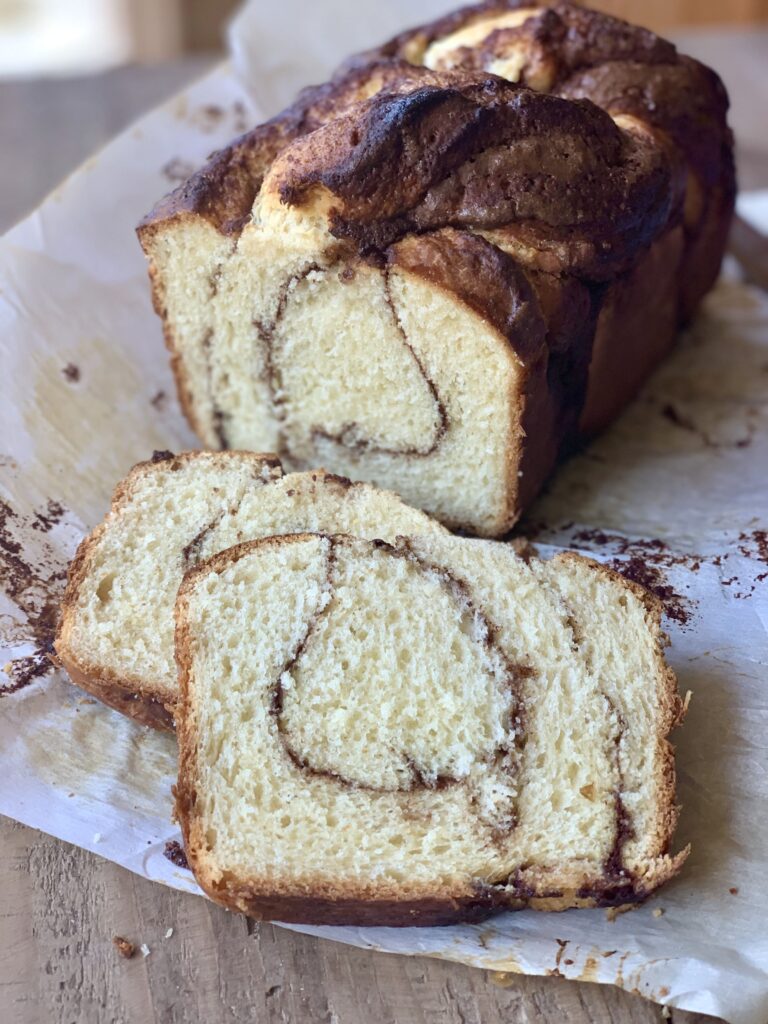
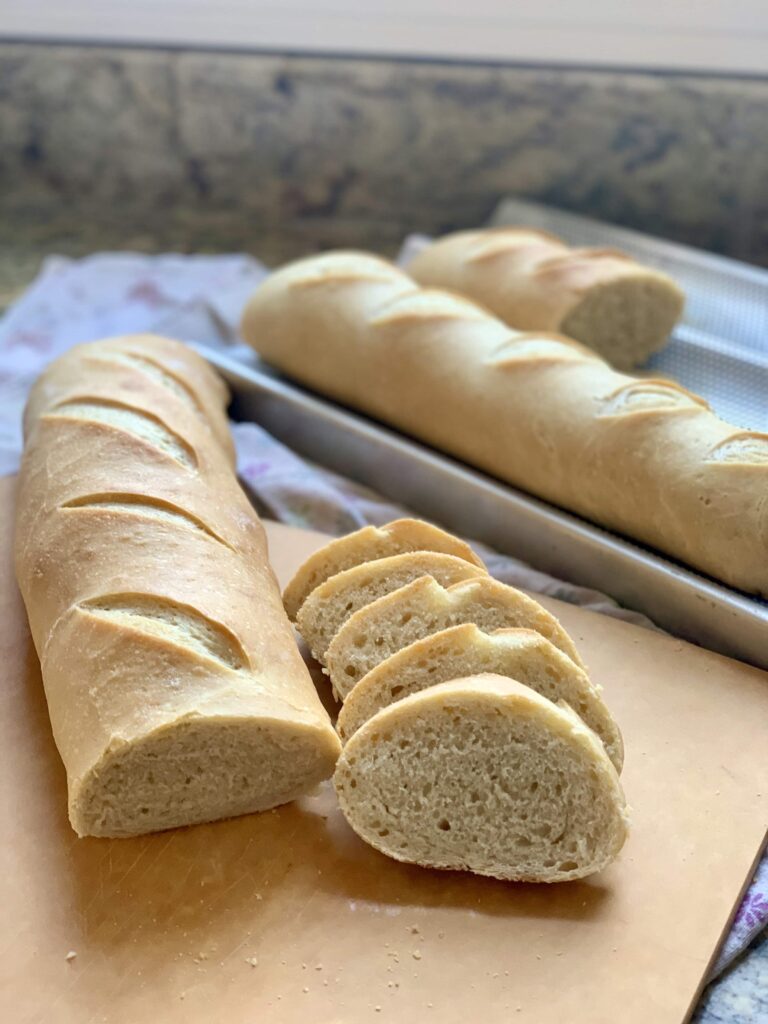
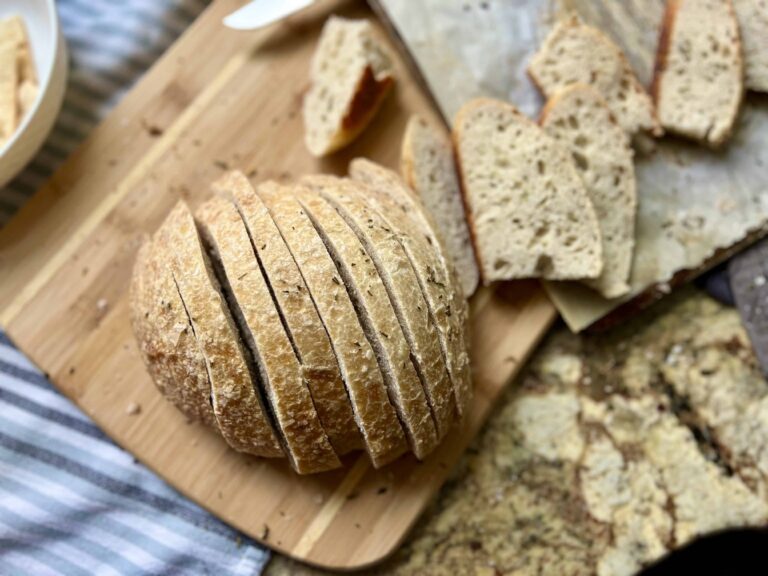
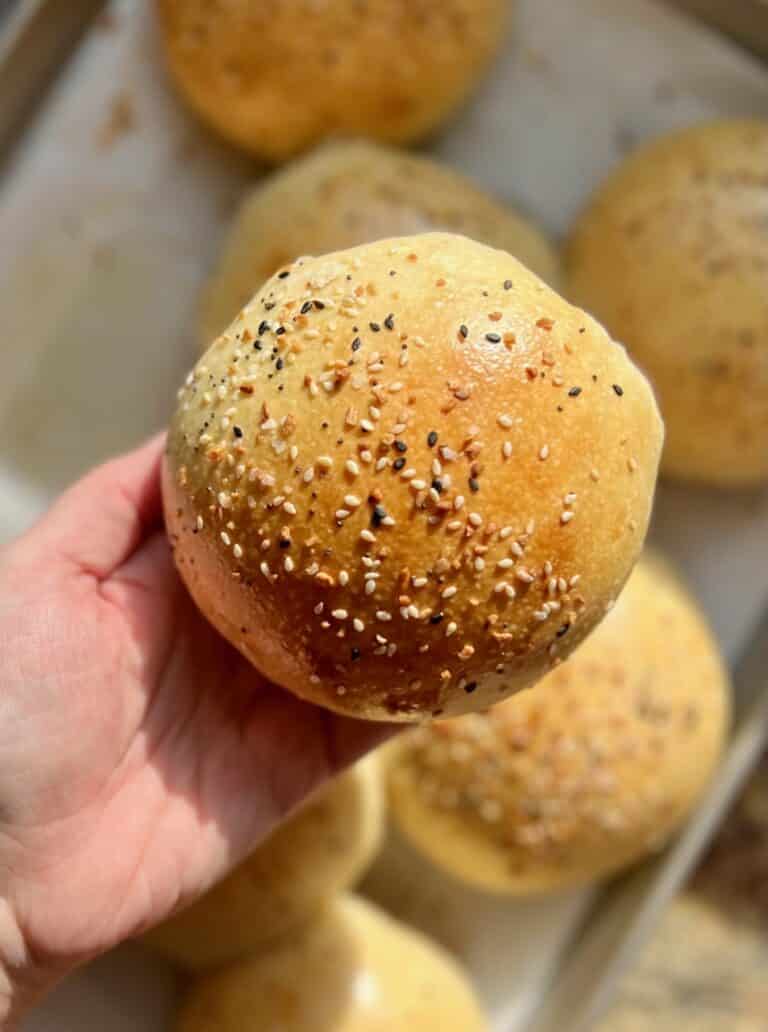
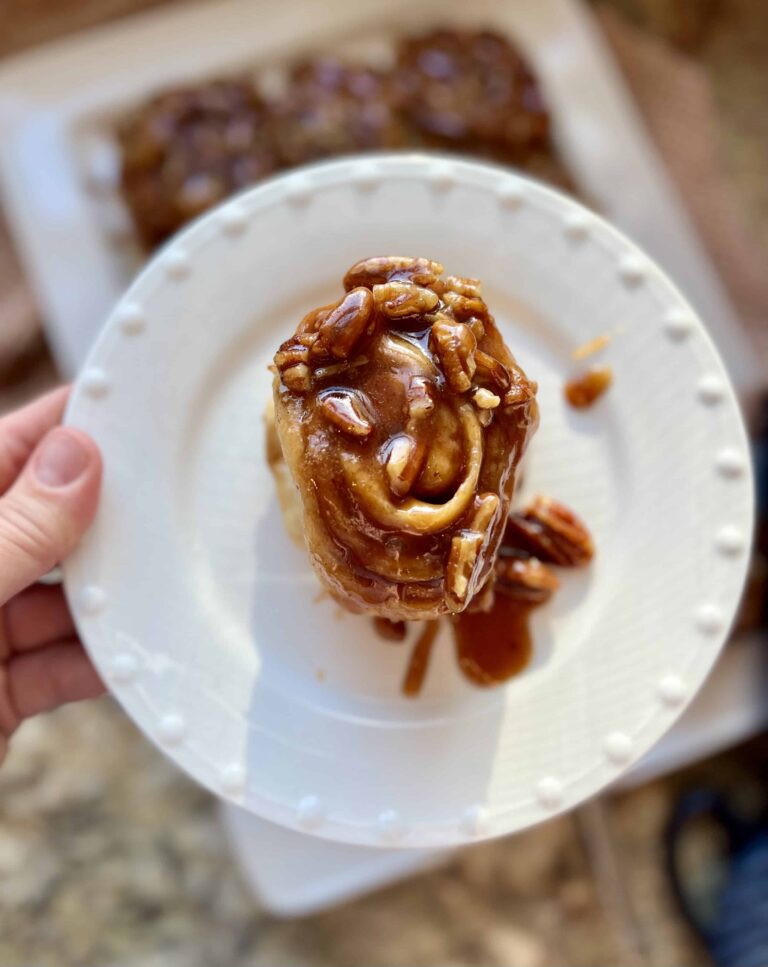

I have it cold
Proofing and soon to go into the oven. So excited to bake it.
I have a question. If I cover in plastic wrap it sinks down on top of dough I would rather have nothing touching it. Any ideas. I don’t have shower caps
Thank you
It’s okay for it to be touching if it’s in the fridge. It will come right off. You can also flour the top of your dough lightly or just not cover it in the fridge. It may get a crust on the top, but you won’t notice it when baked.
Just Made this and it’s Soo delicious! Easy step by step recipe thank you so much for sharing!!
So glad you enjoyed this recipe!
I’ve made this recipe once for my family and my husband said it’s the best sourdough thing I’ve made so far! Question, if I were to make it again but want to get two smaller loaves out of it, would that be possible and if so, when do you recommend splitting the dough in half?
I would split the dough right before adding the cinnamon/sugar. Then add the cinnamon/sugar mixture to each loaf, roll up and proof. Bake time will be a little less too. Maybe 15-20 minutes covered and 10 uncovered.
Wonderful Delicious Recipe!!!
Glad you loved this. Thanks for sharing!
I don’t have time for the warm fermentation before adding the butter paste tonight. Could I put it in the fridge after the stretch and folds overnight and then do the butter paste tomorrow and another long fermentation in the fridge?